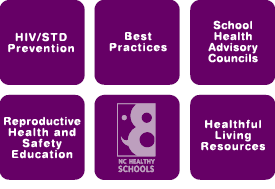NORTH CAROLINA STATE BOARD OF EDUCATION
Policy Manual
Policy Identification
Priority: High Student Performance
Category: Student Health Issues
Policy ID Number: HSP-S-000
Policy Title: Policy regarding physical education in the public schools
Current Policy Date: 01/09/2003 – Amended 04/07/2005
Other Historical Information:
Statutory Reference:
Administrative Procedures Act (APA) Reference Number and Category:
HEALTHY ACTIVE CHILDREN:
Section 1. LOCAL SCHOOL HEALTH ADVISORY COUNCIL
(a) Each school district shall establish and maintain a local School Health Advisory Council to help plan, implement, and monitor this policy as well as other health issues as part of the coordinated school health plan.
(b) The local School Health Advisory Council shall be composed of community and school representatives from the eight areas of a coordinated school health program mentioned in Section 4 (a), representatives from the local health department and school administration.
Section 2. PHYSICAL EDUCATION
(a) To address issues such as overweight, obesity, cardiovascular disease, and Type II diabetes, students enrolled in kindergarten through eighth grades are to participate in physical activity as part of the districts physical education curriculum. Elementary schools should consider the benefits of and move toward having 150 minutes per week with a certified physical education teacher throughout the 180-day school year. Middle schools should consider the benefits of and move toward having 225 minutes per week of Healthful Living Education with certified health and physical education teachers throughout the 180-day school year.
(b) The physical education course shall be the environment in which students learn, practice and receive assessment on developmentally appropriate motor skills, social skills, and knowledge as defined in the North Carolina Healthful Living Standard Course of Study and foster support and guidance for being physically active. In order to meet enhanced goals, these classes should be the same class size as other regular classes.
Section 3. RECESS AND PHYSICAL ACTIVITY
(a) Structured/unstructured recess and other physical activity (such as, but not limited to, physical activity time, physical education or intramurals) shall not be taken away from students as a form of punishment. In addition, severe and/or inappropriate exercise may not be used as a form of punishment for students.
(b) A minimum of 30 minutes of moderate to vigorous physical activity shall be provided by schools for all K-8 students daily. This requirement can be achieved through a regular physical education class and/or through activities such as recess, dance, classroom energizers, or other curriculum based physical education activity programs. However, such use of this time should complement and not substitute for the physical education program.
(c) The physical activity required by this section must involve physical exertion of at least a moderate to vigorous intensity level and for a duration sufficient to provide a significant health benefit to students.
Section 4. COORDINATED SCHOOL HEALTH PROGRAMS (CSHP)
(a) The State Board of Education shall make available to each school district a coordinated school health model designed to address health issues of children. The program must provide for coordinating the following eight components:
(1) safe environment;
(2) physical education;
(3) health education;
(4) staff wellness;
(5) health services;
(6) mental and social health;
(7) nutrition services; and
(8) parental/family involvement.
(b) The North Carolina Department of Public Instruction shall notify each school district of the availability of professional development opportunities and provide technical assistance in implementing coordinated school health programs at the local level.
Section 5. THIS AMENDED POLICY SHALL BE FULLY IMPLEMENTED BY THE 2006-2007 SCHOOL YEAR.
(a) Each local school district shall develop an action plan prepared in collaboration with the local School Health Advisory Council to assist in the implementation of the policy. This action plan shall identify steps that need to be taken each year to fully implement the policy by the 2006-2007 school year and shall include a review and appropriate modification of existing physical education and health curricula.
(b) Action plans shall be submitted to the North Carolina Department of Public Instruction by July 15, 2004.
(c) Progress reports shall be submitted to the North Carolina Department of Public Instruction by July 15, 2005 and 2006.
(d) Beginning July 15, 2007, each local school district in collaboration with the local School Health Advisory Council shall prepare a report annually which will include the minutes of physical education and/or healthful living, physical activity received by students in each school within the district. Indicators that will mark successful implementation and evidences of completion shall be a part of the plan.
(e) This report shall be completed by July 15th each year and remain on file for a period of 12 months to be provided upon request of the North Carolina Department of Public Instruction and local boards of education.
(f) Progress reports and the annual reports shall also include any other information that may be recommended from the State Board of Educations Ad Hoc Committee studying implementation of the physical education and Healthful Living programs in kindergarten through eighth grades.


![]()
![]()
